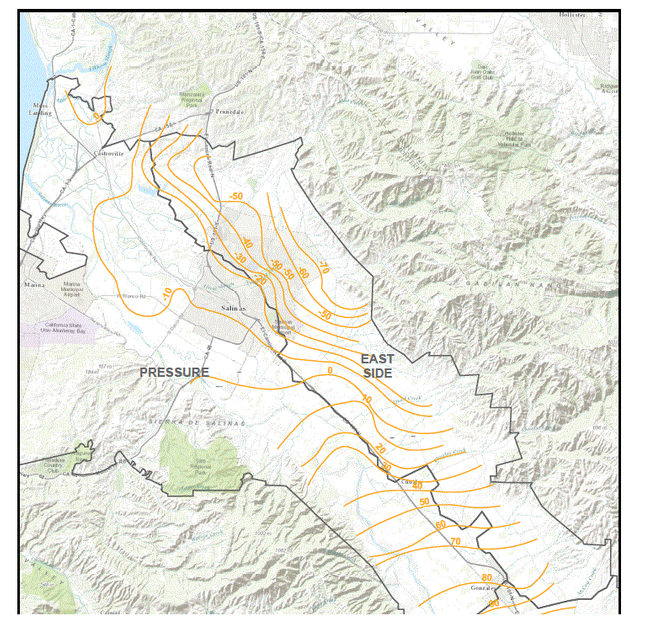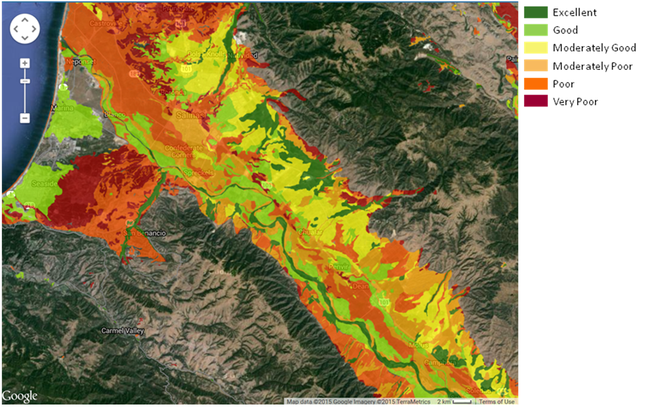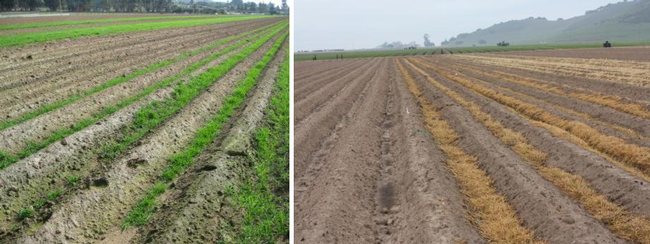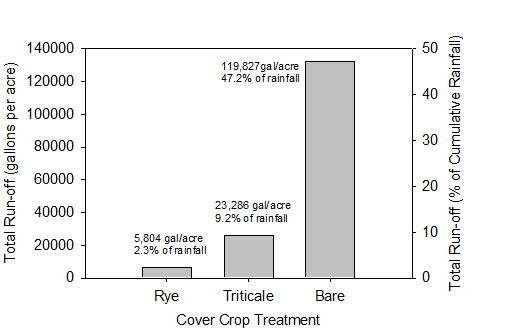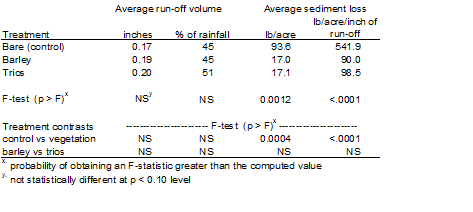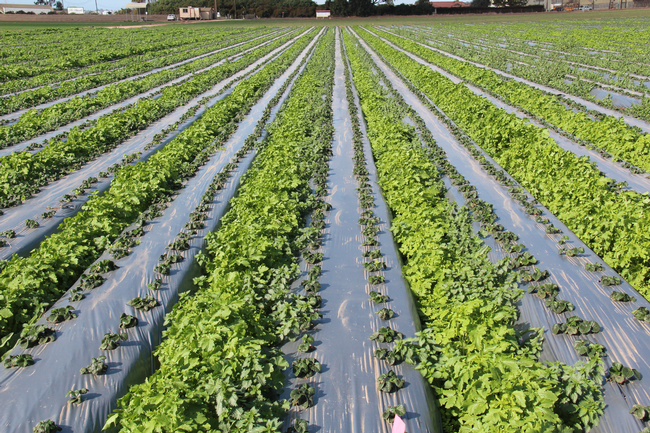Authors: Richard Smith1, Michael Cahn1, Tamara Voss2, Toby O'Geen3, Eric Brennan4, Karen Lowell5 and Mark Bolda6
1 – UC Cooperative Extension, Monterey County; 2 – Monterey County Water Resources Agency; 3 – Dept of Land Air and Water Resources, UC Davis; 4 – USDA Agricultural Research Service; 5 – Natural Resources Conservation Service; 6 – UC Cooperative Extension, Santa Cruz County.
For access to full report please vist http://cemonterey.ucanr.edu/files/219694.pdf
Summary: After four years of drought, groundwater levels in the Salinas Valley are at historically low levels which threaten to adversely affect farming in the Salinas Valley. Given the prospect of a strong El Niño this coming winter, it seems prudent to plan to capture as much of the rainfall as possible to maximize infiltration into the soil and recharge groundwater. The east side of the Salinas Valley is particularly hard hit because it receives a lower proportion of recharge from the Salinas River than other hydrological subunits in the Salinas Valley and its water levels have fallen to lower levels. Low residue cover crops have been shown to effectively increase rainwater infiltration on Chualar loam soils and they provide a practice that we can employ to increase groundwater recharge. Given the low water status of the aquifers and the forecast for significant rainfall, there is an opportunity to proactively implement practices that can maximize water capture this winter. In this article we discuss practices growers can employ in production fields and on farm edges to maximize rainwater infiltration and restore groundwater resources.
Introduction: The four years of drought have left groundwater levels in much of the Salinas Valley are at historically low levels (Figure 1). Due to the types of sediments in Salinas Valley, it is unlikely that the low groundwater levels will cause land to subside; however other deleterious effects may result. The most immediate effect is that shallower wells may become unreliable (i.e., either produce less water or suck in air or sand). This is an immediate expense for growers, who will need to service these wells or drill deeper. As groundwater levels drop below sea level, the salty ocean water will move into coastal aquifers worsening current seawater intrusion issues. Although tremendous efforts have been made in the Salinas Valley to stop seawater intrusion, the prolonged drought increases the potential for seawater to move inland. Groundwater levels on the east side of the Salinas Valley are particularly concerning because they are declining the fastest, which has set up a gradient for saline groundwater to flow toward this part of the valley.
It is encouraging that El Niño conditions continue to persist in the eastern Pacific, and may lead to significant precipitation on the Central Coast this winter. The challenge is to infiltrate as much of this rain as possible to help recharge the groundwater, rather than allow it to escape as run-off into the ocean. Much of the east side agricultural land has moderate to excellent ability to infiltrate rainfall which will directly recharge the underlying aquifer. For example, infiltrating an additional 4 inches of rainfall per acre across 100,000 acres could potentially add 33,000 acre-ft of recharge during the winter. Enhancing recharge in areas with declining groundwater levels would be especially beneficial in reducing seawater intrusion. Increasing the infiltration during severe storm events would also lower flood risk and erosion damage. The objective of this article is to briefly review potential strategies to increase infiltration during the winter storms.
East side Hydrology: Inflows to the Salinas Valley groundwater basin are estimated at 504,000 acre feet/year during an average rainfall year, with about 50 percent from stream recharge (including Nacimiento and San Antonio reservoir releases), 44 percent from deep percolation from precipitation and agricultural return flows, and 6 percent from subsurface inflow from adjacent groundwater basins (MW, 1998). Groundwater recharge in Forebay, Pressure, and Upper Valley subareas of the Salinas Valley Groundwater Basin are primarily from infiltration from the Salinas River. Releases from San Antonio and Nacimiento reservoirs flow down the river recharging the aquifer of these hydrological regions.
Inflow to the East Side Subarea results from a combination of infiltration along small streams on the west side of the Gabilan Range, direct recharge by precipitation on the valley floor, and subsurface inflow from the Pressure and Forebay Subareas (Brown and Caldwell, 2015). In the East Side Subarea, Shallow Aquifer, the seasonal pattern of groundwater head elevation changes are correlated most strongly to annual precipitation (Brown and Caldwell, 2015). In wells with perforations in both the east side shallow and deep aquifers, fall groundwater head generally follows the pattern of cumulative precipitation surplus, with head declining during relatively dry periods and rising during relatively wet periods. There is, however an overall long-term decline in groundwater head over the period of record (1953-2013) for the East Side subarea (Figure 1) (Brown and Caldwell, 2015). Groundwater levels on the east side of the Salinas Valley are particularly concerning because they have set up a gradient for saline groundwater to flow toward this area of the Valley (Figure 2). The cumulative storage change for the East Side subarea has also been negative for the entire period of record (1944-2013), investigated in “State of the Salinas River Groundwater Basin” report, ending at about -332,600 acre-feet in 2013. (Brown and Caldwell, 2015)
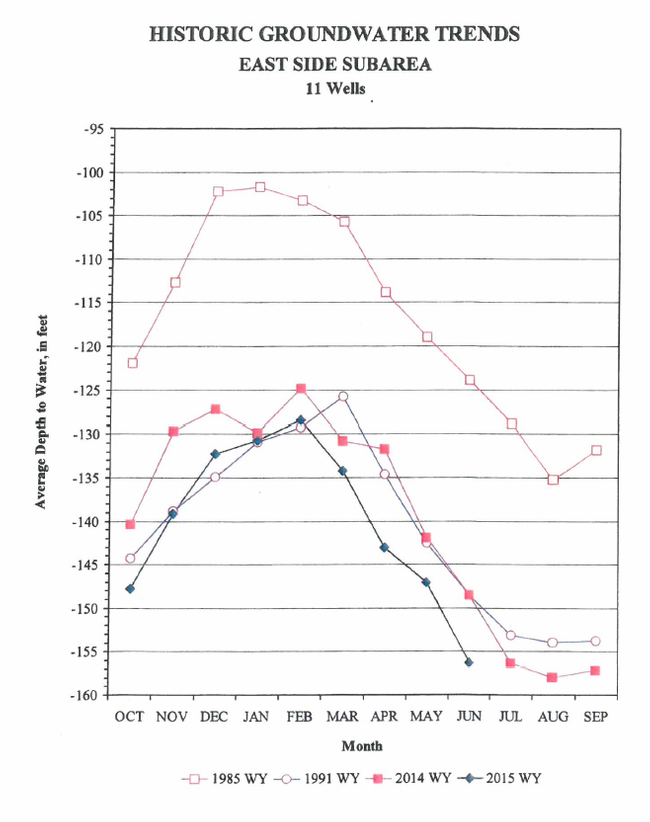
Figure 2. Groundwater head elevation in the Pressure 180-foot and East Side shallow aquifers. Source: Monterey County Water Resources Agency; Map date August 20, 2015.
Soil Types and Groundwater Recharge Potential: Common soil series on the east side of the Salinas Valley include Chualar, Antioch, Arroyo Seco, Danville, Elder and Placentia. The Chualar series is the most common soil type and has moderately good potential for infiltrating water from winter storms (Table 1, Figure 3). However, it has a tendency to form a crust and shed water during high intensity rainfall events. Other common soils such as Arroyo Seco, and Elder are highly permeable and have excellent potential to recharge groundwater. Soils such as Antioch are poorly suited, but deep tillage increases the permeability of subsoil horizons and greatly improve its recharge capability. Soils such as Placentia, Danville and Salinas have slow percolation rates. These soils have fine texture throughout the profile yet improving soil structure could increase their ability to accept water.
Table 1. Summary of groundwater recharge potential ratings of common soils on the east side of the Salinas Valley based the Soil Agricultural Groundwater Banking Index (O'Geen et al., 2015).
|
Soil Series |
Groundwater Recharge Potential Rating |
|
|
|
No Deep Tillage |
Soil Modified by Deep Tillage |
|
Chualar |
Moderately Good |
Moderately Good |
|
Antioch |
Poor |
Good |
|
Arroyo Seco |
Excellent |
Excellent |
|
Placentia |
Poor |
Poor |
|
Danville |
Moderately poor |
Moderately poor |
|
Elder |
Excellent |
Excellent |
|
Gloria |
Very poor |
Moderately poor |
|
Pico |
Good |
Good |
|
Rincon |
Poor |
Poor |
|
Cropley |
Poor |
Poor |
|
Salinas |
Poor |
Moderately poor |
Figure 3. Suitability of east side soils (modified by deep tillage) for groundwater recharge (O'Geen et al., 2015).
Practices to Increase Rain Water Infiltration: The overall approach to increase infiltration on agricultural land during winter storms is to implement practices that maximize infield infiltration in conjunction with practices on field edges which slow and retain run-off so that it has chance to infiltrate.
IN FIELD PRACTICES
Full-Season Cover Crops: Cover crops can improve the infiltration of water into the soil by protecting the soil surface, eliminating surface crusting caused by the impact of raindrops and maintaining aggregate stability and creating soil macropores. Full-season cover crops are those that are planted in the fall and incorporated into the soil in late winter or early spring. They increase infiltration by creating root pathways that facilitates downward movement of water. In addition, they slow the movement of water over the soil surface giving it more time to infiltrate. Downward movement of rainwater through the soil leaches salts that have accumulated over the growing season and contributes to groundwater recharge. However, full-season cover crops remove water from the soil by their transpiration later in the growth cycle and, in low rainfall years, they may dry the soil and little recharge will occur. For instance in a trial conducted from 2010-11, we observed 5.5 inches of water percolated into the soil in the bare fallow treatment, but only 3.0 inches in the full-term cover crop treatment (incorporated into the soil in March). The difference in the two treatments was due to evapotranspiration by the cover crop later in February and March when day length increases. This is good for reducing nitrate leaching, but less useful for groundwater recharge. Given the current drought situation and a pressing need to facilitate groundwater recharge, understanding the impact of cover crops on infiltration and options to manage them in Salinas Valley settings is critical. Low residue cover crops offer a unique approach to address operational constraints that may make full season cover crops impractical in the vegetable cropping operations that cover much of the land in the Salinas Valley.
Low Residue Cover Crops in Vegetables: Low residue cover crops are planted in the fall and killed 60 days later (e.g. mid-January) when they have produced about 0.5 tons/acre of dry biomass. This is typically when they've produced about 10 to 20% of the potential biomass of a full-season cover crop. Typical varieties used in vegetable production systems for low residue cover crops include cereals like rye (Merced and AGS104), as well as winter-dormant triticales (Trios 888). Both are typically sown in the fall following listing; earlier planting dates can provide protection to the soil for early storms in November and December.
Seeding can be done by dribbling the seed onto the furrow bottom, followed by shallow harrowing. It is important to use sufficient seed (e.g. 80-100 lbs rye seed/acre) to get rapid growth that can quickly protect the soil from early storms. Planting seed in the furrow is tricky because soil can fall from the edge of the bed back into the furrow (after the harrow passes) and bury the seed too deeply. The ideal seeding depth is 1-2 inches; four inches is too deep and will greatly reduce seed emergence. Under ideal conditions the soil may be moist enough to germinate the seeds without irrigation, or an early rain provides the moisture for germination.
Winter-dormant triticales (e.g. Trios 888) grow more slowly in the winter, which may reduce the risk of producing too much biomass that could be a problem in preparing the soil for the subsequent cash crop (see photos below). Low residue cereal cover crops are typically killed with an herbicide such as glyphosate or a grass selective material such as clethodim or sethoxydim when 60 days old; cereal cover crops on the furrow bottom are difficult to kill mechanically. At this stage the cover crop residue has a low C:N ratio (9-12) and decomposes rapidly in the presence of favorable moisture and temperatures. In studies conducted from 2009 to 2011, we observed that sufficient killed residue remained on the soil surface for 4-6 weeks to continue to protect the surface from raindrop impact and soil crusting. The dead roots of the killed cover crop retain their function of providing channels for rapid infiltration as well. Therefore though the cover crop only grew until mid-January, the soil was protected by the cover crop from about December to mid-March. The cover crop and its residue reduced runoff on a Chualar loam soil where our studies were conducted. We observed that 47.2% of the rainfall ran off of the field in the bare fallow treatment, compared with only 2.3% runoff in the rye and 9.2% in the winter dormant triticale (Figure 5). The rye cover crop increased the amount of water that infiltrated into the soil by 119,827 gallons/A (1/3 of an acre-foot) over the bare fallow treatment. The increased infiltration in the low residue rye cover crop treatment increased the quantity of chloride and sodium leached from the soil by >80% over the bare fallow treatment. This salt leaching provides considerable agronomic benefit, as low rainfall years allow salts to reach levels that may damage crops.
Figure 4. Winter dormant triticale (Trios 102) planted on the furrow bottom. Photo on right is 3 weeks after being treated with glyphosate. Note dead residue covers furrow bottoms.
Figure 5. 2009-2010 Trial. Total runoff from cover crop and bare treatments between mid January and March 7, 2010.
Weed control in the low residue cover crops can be carried out by lillistoning the bed tops and sides, but the furrow sweeps must be lifted to avoid disturbing the protective cover crop residue. You can see an example field preparation following a low residue cover crop in this video https://www.youtube.com/watch?v=k0oVVJ_BA7s . Initial studies with this technique were done with vegetables. There is a delicate balance of covering the soil and obtaining the benefits of increased water infiltration, but having the residue decompose quick enough to allow for ease of bed preparation for planting the subsequent vegetable crop. The quantity of cover crop residue at the time of killing and the spacing of the rain events that allow for cover crop decomposition determines how successfully this technique works. To be on the safe side, in your first efforts using this technique, it is prudent to only use this technique on fields that are scheduled for planting later in the spring to make sure the residue does not create issues for the subsequent cash crop (contact Richard for specific questions: 831-759-7357).
Low Residue Cover crops in Strawberries: Low residue cover crops can also be used in strawberry production systems during the winter. This technique has been used to some extent by growers on hills, and can greatly reduce erosion and improve the water quality of run-off (Table 2). However, cover crops in furrow bottoms were less effective in reducing the quantity of runoff from strawberry fields than in listed vegetable beds. The lack of increased infiltration is due to the volume of runoff generated by beds covered with plastic; soils on the furrow bottom quickly become thoroughly saturated and water quickly runs off. This may be particularly problematic on steeper ground where runoff from individual furrow drainage joins at the end of the rows and becomes an extremely erosive concentrated flow. In this setting a particularly dense seeded cover crop, particularly at the end of rows, may help dissipate the energy of the concentrated flow moving downslope. Often it is necessary to address the lack of improved in-field infiltration by use of underground outlets and sediment basins where runoff carries high sediment loads. Where sediment loads are minimal, vegetated ditches may be helpful to slow the water and allow for infiltration in the ditch (see below).
The use of furrow-bottom cover crops in strawberry systems is still very useful on the east side of the Salinas Valley and other locations on slopes because of reductions in sediment loss. Cover crop choice is important in strawberry systems. For example, fast growing cover crops like barley require more management early in the winter. In our studies, we found that by late December, barley was tall enough to begin shading the strawberry plants. At that point, it can be managed by weed wacking or treatment with a grass selective herbicide like sethoxydim or clethodim (selective for killing grass and do not damage strawberries). In contrast to barley, winter-dormant triticale (Trios 102) grows more slowly and therefore doesn't require management until about late January.
Table 2. Run-off and sediment loss during rain events in a strawberry trial, 2006-07. Data were collected from 11 storm events totaling 4.28 inches.
Low Residue Cover crops: Organic Systems: Low residue cover crops can be used in organic fields as long as they can be killed before they produce too much biomass. Grass cover crops (i.e. cereals) are not recommended, because they are difficult to kill with tillage. Organic herbicides work better on young plants (i.e., cotyledon stage) and are weak on grasses. Growing mustard in the strawberry furrows is one exciting approach that seems to have lots of potential in this region. We've evaluated this over several years at the USDA-ARS in Salinas and have been impressed because mustard establishes quickly with relatively little moisture and is easy to kill with a single cut with a weed whacker. We used hand pushed planters like the ‘Clean Seeder AP' to plant a single line of mustard in the furrow bottom in early December, and typically weed wacked it in late January to early February when it was about the height of the strawberry bed top. Unlike grass cover crops, mustard does regrow after its cut down. After weed whacking, the high-nitrogen mustard residue decomposes quickly and creates relatively few challenges when the furrows are shallow-cultivated to prepare them for strawberry harvesting. Planting a single line in the furrow center helps to keep the base of the mustard plants away from the plastic, which minimizes damage to the plastic during weed wacking. Several mustard cover crop varieties (i.e. Kodiak, Ida Gold, and Caliente) can work, although Ida Gold seems especially well-suited to this system. It grows tall and fills in the furrow quickly, and its relatively large seeds seem more tolerant to deeper planting depths. An appropriate seeding rate for Ida Gold mustard in strawberry furrows is about 10 pounds/acre (approximately $30/acre for seed) which will result in about 30 to 40 plants per foot of furrow bottom. To reduce labor costs with planting mustard, the USDA-ARS has developed a simple planter that plants two strawberry furrows at a time, and will be available for growers to borrow to try. The planter will be demonstrated during a field day at the USDA-ARS in September, and about 1000 pounds of free mustard seed will be available for interested growers to try. Although we have not measured runoff from mustard furrows, we have observed that it dries down furrows and therefore will likely reduce run-off and sediment loss. More research is needed to document the effect of mustard on infiltration and ground water recharge when planted in strawberry furrows, but observation in work done thus far suggests such plantings may be beneficial.
Figure 6. Ida Gold mustard ready for weed whacking, January 30, 2014.
Other In-Field Practices to Increase Infiltration:
- Surface application of gypsum can improve aggregation of soil particles, which improves soil structure, reduces crusting and thereby increases water infiltration into the soil. Gypsum provides calcium which changes the manner in which soil particles are able to flocculate (come together) as aggregates. This approach can be particularly effective for soils that crust, such as those found on the east side of the Salinas Valley. To be effective, gypsum needs to be applied on the surface of the soil (not incorporated) before the first rainfall. The effect of the gypsum declines over time as the rainfall solubilizes the gypsum and carries it away from the soil surface where it is needed.
- Leaving fields unlisted: For fields that will be planted in the late spring, leaving them flat (unlisted) through the winter may also help infiltrate more of the rainfall, as unlisted fields will reduce concentrated flow in furrows where soil may become saturated. If it is possible to leave fields unlisted, leaving a rough soil surface will also help infiltrate a greater portion of the rainfall by creating less runoff potential.
- Tillage can improve water infiltration by breaking the soil crust and slowing runoff by creating a torturous path for the water to follow. Obviously, obtaining access to the field with tillage equipment can be difficult to impossible in wet years.
- 80-inch wide beds appear to have less runoff than 40-inch wide beds in moderate rain storms. However, it is unclear how well 80-inch beds will reduce runoff in a large El Niño rain event of 3 or more inches.
